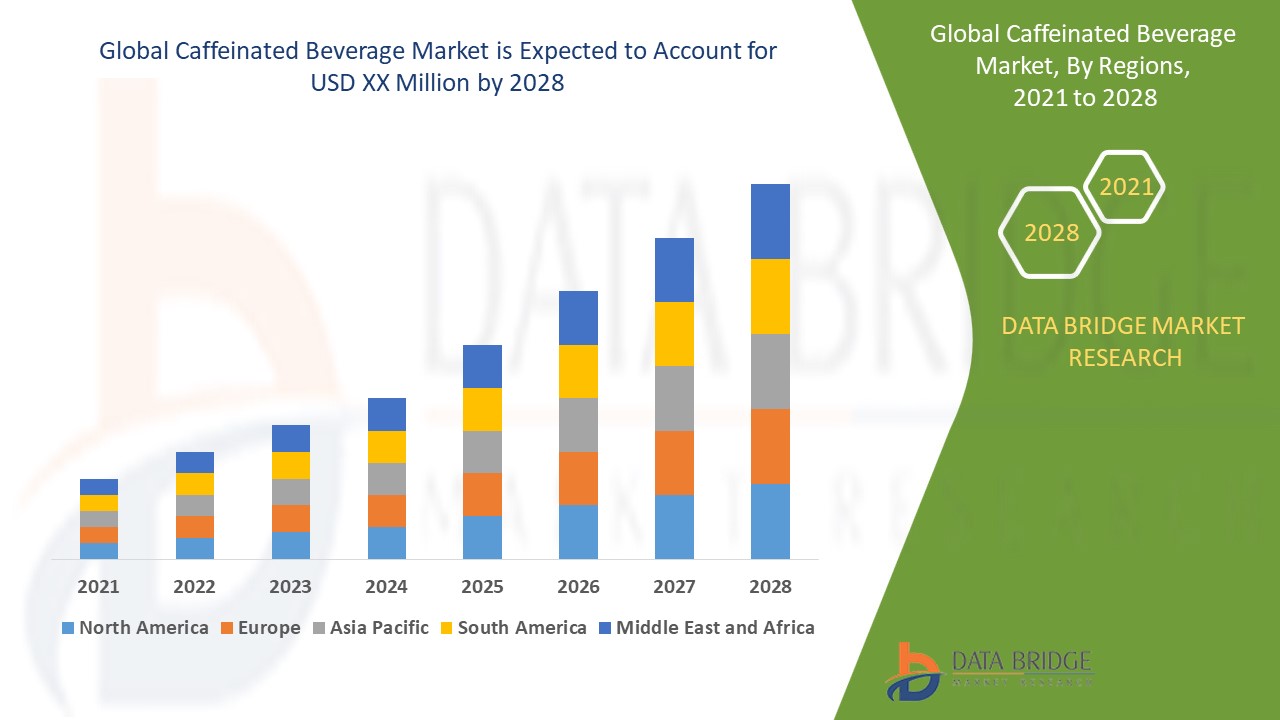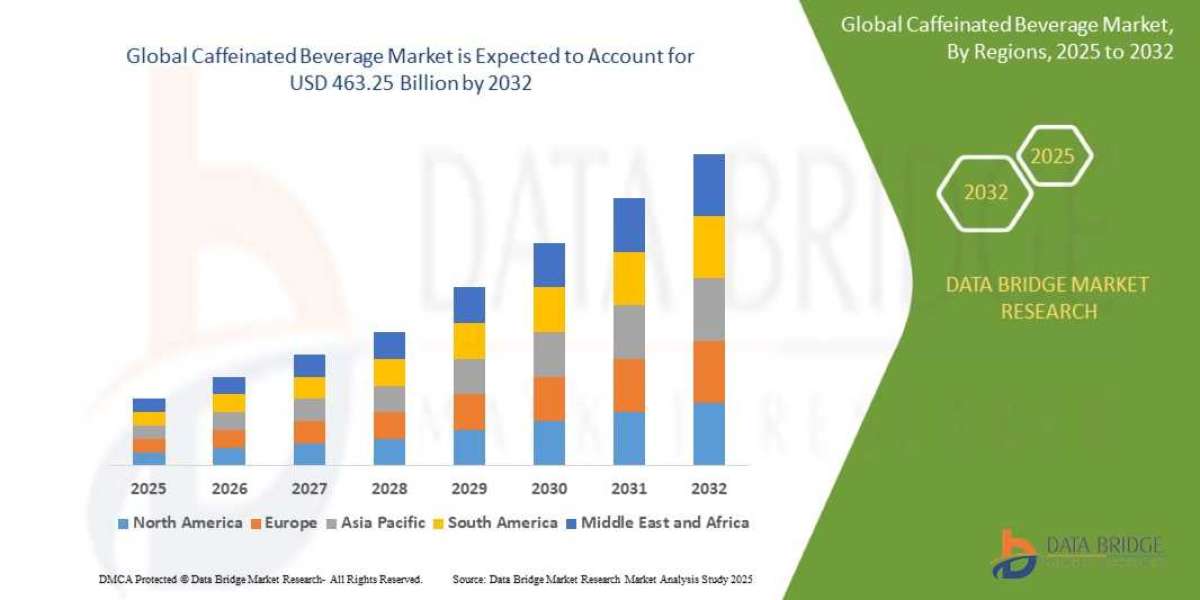"
Caffeinated Beverage Market Size And Forecast by 2032
The study also emphasizes the broader implications of the strategies employed by these companies on the Caffeinated Beverage Market. Their innovations and market contributions not only shape the industry today but also pave the way for its future trajectory. By analyzing these companies, the report equips stakeholders with actionable insights to understand competitive positioning, identify growth opportunities, and devise strategies to thrive in this dynamic and evolving market landscape.
The global caffeinated beverage market size was valued at USD 273.68 billion in 2024 and is projected to reach USD 463.25 billion by 2032, with a CAGR of 6.80 % during the forecast period of 2025 to 2032.
The Caffeinated Beverage Market research report offers valuable insights into industry statistics, including market size, share, and revenue performance. It provides a comprehensive overview of key players, their strategies, and their impact on the competitive landscape. This analysis helps stakeholders identify areas of growth and prioritize investment opportunities.
Get a Sample PDF of Report - https://www.databridgemarketresearch.com/request-a-sample/?dbmr=global-caffeinated-beverage-market
Nucleus is a secure, cloud-based platform designed to streamline data transfer and management for businesses. Its intuitive interface offers practice administrators and financial managers advanced filtering options, enhancing operational efficiency. By integrating various data sources, Nucleus enables effective prioritization of critical exposures, incorporating business context and threat intelligence to bolster security measures. Additionally, Nucleus supports seamless collaboration among multiple users across different applications, fostering rapid iteration and teamwork. Its deployment flexibility allows installation on-premises or via preferred cloud service providers, ensuring scalability and adaptability to meet diverse organizational needs.
Get More Detail: https://www.databridgemarketresearch.com/nucleus/global-caffeinated-beverage-market
Which are the top companies operating in the Caffeinated Beverage Market?
The Top 10 Companies in Caffeinated Beverage Market include leading firms. These companies are known for their strong market presence, innovative products, and ability to meet customer demands. They continue to drive growth in the industry through their commitment to quality and innovation, making them key players in the Caffeinated Beverage Market.
The global caffeinated beverage market is experiencing significant growth, driven by factors such as increasing consumer demand for energy-boosting drinks, changing lifestyle patterns, and a rising focus on health and wellness. The market is characterized by a wide range of product offerings, including energy drinks, coffee, tea, and carbonated soft drinks. Caffeine, the key ingredient in these beverages, is known for its stimulating effects on the central nervous system, making it a popular choice among consumers looking for a quick energy boost.
**Segments**
- Energy Drinks: Energy drinks are one of the fastest-growing segments in the caffeinated beverage market, driven by their popularity among young consumers and athletes seeking a quick energy boost.
- Coffee: The coffee segment remains a dominant player in the market, with a wide variety of offerings such as ready-to-drink coffee, ground coffee, and coffee pods.
- Tea: The tea segment is also witnessing strong growth, fueled by the increasing popularity of herbal and specialty teas that offer caffeine along with health benefits.
- Carbonated Soft Drinks: While traditional carbonated soft drinks are facing challenges due to health concerns, some brands are incorporating caffeine to attract consumers seeking an energy boost.
**Market Players**
- The Coca-Cola Company: As a key player in the global beverage market, Coca-Cola offers a range of caffeinated beverages, including energy drinks like Monster and NOS, as well as coffee and tea products.
- PepsiCo, Inc.: Another major player in the industry, PepsiCo markets popular energy drinks like Mountain Dew Kickstart and Rockstar, along with coffee brands such as Starbucks ready-to-drink products.
- Red Bull GmbH: Red Bull is a prominent player in the energy drink segment, known for its iconic can design and marketing campaigns that target young consumers and athletes.
- Starbucks Corporation: With its extensive chain of coffee shops worldwide, Starbucks is a leading provider of caffeinated beverages, offering a variety of coffee-based drinks to cater to different consumer preferences.
In conclusion, theThe global caffeinated beverage market is poised for continued growth, driven by evolving consumer preferences and lifestyle trends. While traditional segments like coffee and tea continue to maintain a strong presence in the market, the rise of energy drinks has emerged as a key driver of growth, particularly among younger consumers and athletes seeking a quick energy boost. Energy drinks have capitalized on their convenience and marketing strategies to carve out a significant share of the market, with brands like Red Bull and Monster leading the way with their targeted advertising campaigns.
In recent years, there has been a shift towards healthier and more natural ingredients in caffeinated beverages, with consumers becoming more conscious of their overall well-being. This has led to the popularity of herbal and specialty teas that offer both caffeine and health benefits, tapping into the growing trend of functional beverages. Companies are also innovating with new product formulations and flavors to cater to changing consumer demands, such as reduced sugar options and plant-based ingredients.
The competitive landscape of the caffeinated beverage market is intense, with major players like Coca-Cola, PepsiCo, Red Bull, and Starbucks constantly innovating to stay ahead. These companies invest heavily in marketing and product development to differentiate their offerings and appeal to a diverse consumer base. Partnerships and collaborations are also becoming more common in the industry, as companies seek to leverage each other's strengths and reach new market segments.
Looking ahead, sustainability and environmental concerns are expected to play a larger role in shaping the caffeinated beverage market. Consumers are increasingly looking for eco-friendly packaging and ethically sourced ingredients, prompting companies to rethink their supply chains and packaging practices. Brands that can effectively communicate their sustainability efforts and offer transparency in their production processes are likely to gain a competitive edge in the market.
In conclusion, the global caffeinated beverage market is dynamic and competitive, with a diverse range of products catering to varying consumer preferences. While established segments like coffee and tea continue to thrive, the rise of energy drinks and functional beverages presents new opportunities for growth and innovation. Companies that can adapt**Market Players**
- Keurig Dr Pepper, Inc.
- Monster Energy Company
- PepsiCo
- RED BULL
- Rockstar, Inc.
- The Coca-Cola Company
- Arizona Beverage Company
- BAWLS ACQUISITION
- Living Essentials Marketing, LLC
- LUCOZADE
- Beaver Buzz
- COTT CORPORATION
- Clear Cut Phocus
- Jolt Cola
- SlimFast
- LIMITLESS
- Danone S.A.
- Nurish Brands, Inc.
In the competitive landscape of the caffeinated beverage market, these major players play a significant role in shaping industry dynamics and market trends. Keurig Dr Pepper, Inc., known for its wide range of coffee and soft drink products, competes with players like Monster Energy Company and PepsiCo, which are prominent in the energy drink segment. RED BULL and Rockstar, Inc. are recognized for their strong presence in the energy drink market, while The Coca-Cola Company offers a diverse portfolio of caffeinated beverages, including energy drinks, coffee, and tea products. Other players like Arizona Beverage Company, BAWLS ACQUISITION, and Living Essentials Marketing, LLC also contribute to the market with their unique offerings.
These market players are continuously striving to innovate and differentiate themselves in the highly competitive caffeinated beverage market. They invest heavily in research and development to introduce new flavors, formulations, and packaging innovations that cater to evolving consumer preferences. Marketing strategies and brand
Explore Further Details about This Research Caffeinated Beverage Market Report https://www.databridgemarketresearch.com/reports/global-caffeinated-beverage-market
Key Insights from the Global Caffeinated Beverage Market :
- Comprehensive Market Overview: The Caffeinated Beverage Market is witnessing rapid expansion, fueled by increasing demand for advanced solutions and evolving consumer needs.
- Industry Trends and Projections: The market is projected to grow at a CAGR of X%, with a notable shift towards digitalization and automation in the coming years.
- Emerging Opportunities: There is a rising demand for eco-friendly products and services, creating new business avenues within the market.
- Focus on RD: Companies are prioritizing innovation and research to develop next-generation products and enhance competitive advantages.
- Leading Player Profiles: Market leaders continue to drive growth through strategic acquisitions and product innovation.
- Market Composition: The market is segmented by product type, region, and application, with a mix of both established and emerging players.
- Revenue Growth: The market is experiencing significant revenue growth, attributed to increased consumer spending and the expansion of digital services.
- Commercial Opportunities: There are substantial opportunities for expansion in untapped regions, particularly in developing economies where demand is rising.
Our reports cater to diverse audiences by offering localized analyses in multiple regional languages. These reports provide tailored insights for specific regions, enabling businesses and stakeholders to access relevant information for informed strategies.
Get More Reports:
Global Roofing Chemicals Market Size, Share, and Trends Analysis Report – Industry Overview and Forecast to 2030
Global Diphtheria Market Size, Share, and Trends Analysis Report – Industry Overview and Forecast to 2029
Global Digital Ray Substation Automation Market Size, Share, and Trends Analysis Report – Industry Overview and Forecast to 2030
Global Olivopontocerebellar Atrophy (OPCA) Market Size, Share, and Trends Analysis Report – Industry Overview and Forecast to 2028
Global Battlefield Management Systems Market Size, Share, and Trends Analysis Report – Industry Overview and Forecast to 2028
Global Antiallergics Drugs Market Size, Share, and Trends Analysis Report – Industry Overview and Forecast to 2030
Global Citrullinemia Market Size, Share, and Trends Analysis Report – Industry Overview and Forecast to 2028
Global Playout Automation and Channel-In-A-Box Market Size, Share, and Trends Analysis Report – Industry Overview and Forecast to 2027
Global Bio degradable Films Market Size, Share, and Trends Analysis Report – Industry Overview and Forecast to 2028
Global Vibration System Market Size, Share, and Trends Analysis Report – Industry Overview and Forecast to 2031
Global Cloud Native Storage Market Size, Share, and Trends Analysis Report – Industry Overview and Forecast to 2031
Global Manual Car Charger Market Size, Share, and Trends Analysis Report – Industry Overview and Forecast to 2031
Data Bridge Market Research:
Contact Us:
Data Bridge Market Research
US: +1 614 591 3140
UK: +44 845 154 9652
APAC: +653 1251 975














